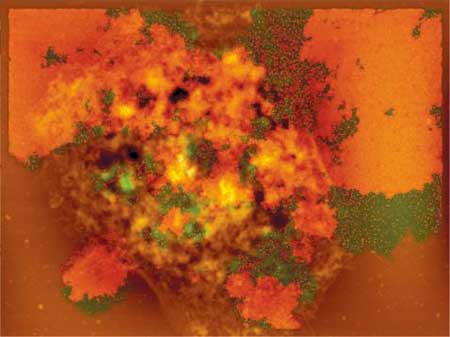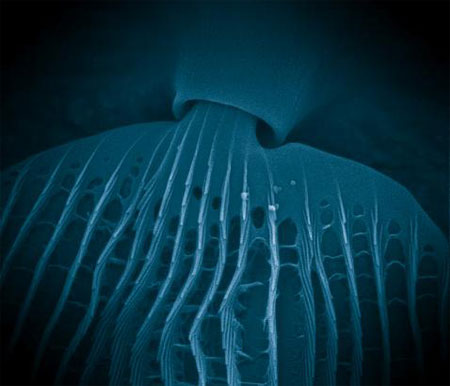| Posted: November 6, 2007 |
Nanotechnology inspired art at Prague festival for arts, sciences and technologies |
|
(Nanowerk News) ENTER3, the 3rd festival for arts, sciences and technologies will take place in Prague, Czech Republic, from November 8-11, 2007. ENTER is part of the annual Week of Science and Technology, the project of the Czech Academy of Sciences. From the organizer:
|
|
For the third time we introduce ENTERmultimediale festival, however, this time with profound changes. Even a first glance suggests the difference: the title of the new media art festival reads as short as one word: ENTER. The keyboard element used most, to enter a new line of text, today symbolises more of an action, the beginning of a process, a becoming.
|
|
However, this symbol is not necessarily positive all the way round. It can also denote destruction, both metaphorically and literally. When your Personal Computer (PC) asks: “Are you sure that you want to permanently delete the selected item(s)? “, you may double-check what you are about to delete. But sometimes, when in a hurry, you can press the button and lose all unsaved data. Your digital past can be is lost, the past which has been increasingly machine dependent ever since the `80s. And what about intercontinental ballistic missiles? Most likely they are shot via one press of the enter key on an army super-computer keyboard, with the disappearance of whole cities or even states/countries as consequence.
|
|
The ENTER festival is now both more radical and universal at the same time. Besides keeping an eye on technological developments in art and their intersections with science, the festival has become more political, sharing interest in social context as well as the history and future of humans. Still, a focus on the role of science in all these issues remains. What are the influences and their directions? Is art working for science, or science for art?
|
|
ENTER3 on the one hand introduces/presents an emerging generation of artists who are entering science labs, working and living on computer networks daily, as well as explores scientific theories and theories of artistic “avant-gardes”.
|
|
On the other hand, the festival introduces for the first time on the international level, a retrospective exhibition of Frank J. Malina, a renowned pioneer of light kinetic art, but also a rocket engineer and founder of Leonardo journal which has created one of the first communities of artists and scientists working together.
|
|
CIANT joined Leonardo, Hexagram and Pépinières européennes pour jeunes artistes in order to organise an international conference MutaMorphosis which aims to challenge arts and sciences while focusing on extreme environments.
|
|
It is a great pleasure today to see the ENTER festival evolving. It offers the audience a new kind of event which looks back in history and ahead to the future at the same moment, and which connects the artistic, research and scientific activities of more than 100 practitioners from all continents.
|
|
Pavel Smetana, October 2007
|
|
Here are two nanotechnology-inspired installations:
|
|
Paul Thomas in collaboration with Kevin Raxworthy: Midas – A visual and sonic installation that amplifies certain aspects of experience at a nano level
|
 |
|
The Midas project takes its name from the fabled Midas, King of Phrygia to whom Dionysus gave the power of turning all that he touched into gold. The metonymic work is based on research developed at SymbioticA and the Nanotechnology Research Institute at Curtin University of Technology. Midas uses data gathered from an Atomic Force Microscope (AFM) in contact and force spectroscopy mode which is translated into images and sound files. By scanning a skin cell with both a gold-coated and uncoated cantilever tip, specific recorded data for each event can be comparatively examined.
|
|
In this process the transition of atomic vibrations between a skin cell and gold is demonstrated. The recorded data of vibrating atoms is translated into sound files, presented in conjunction with a genetic algorithmic visualisation. The algorithm is written to contaminate the skin cell’s image replicating a Drexlierian deterritorialising landscape for semi autonomous nano assemblers. The semi autonomous self-organizing nanobots affect the AFM’s imaging of the skin cell transmuting it into gold. The experience of touch is represented in the process of the viewer making contact with a button constructed from an imaged skin cell. This action releases nanobots, seeded from the recorded data. Simultaneously, sub sonic speakers amplify the data of the atoms vibrations, making that which is infinitely small, both audible and palpable.
|
|
Victoria Vesna & James Gimzewski: Blue Morph, installation
|
 |
|
Blue Morph is a piece in progress that has been under development for the past two years. This project is a close collaboration of an artist and scientist interested in collective consciousness shifts in relation to sound, vibration and color. The piece is based on vibration measurements of the metamorphosis of a caterpillar into a Blue Morpho butterfly.
|
|
The Blue Morpho butterfly in particular interested us for the nano-photonics involved in iridescent Yves Klein magical blue color that is not pigment at all but patterns and structure. This butterfly has intrigued scientists for generations with its optical engineering – the lamellate structure of their wing scales has been studied as a model in the development of fabrics, dye-free paints, and anti-counterfeit technology such as that used in currency. Today, its dazzling iridescent wings are giving rise to a market to try to mimic its wonder and create a counterfeit proof currency and charge cards.
|
|
Most important of all in relation to this project is the realization that sounds of metamorphosis are not gradual or even that pleasant as we would imagine it. Rather they happen in sudden (violent) surges that are broken up with stillness and silence. It is also interesting to note that there are the eight pumps or “hearts” that remain constant throughout the changes, pumping the rhythm in the background. This juxtaposed with the abstracted images of the wings on nanoscale is pretty powerful on its own, but we wanted to make this an interactive experience that would be inverse of what one would expect.
|


